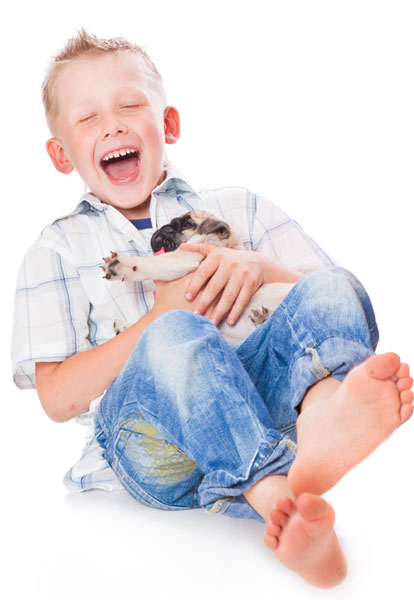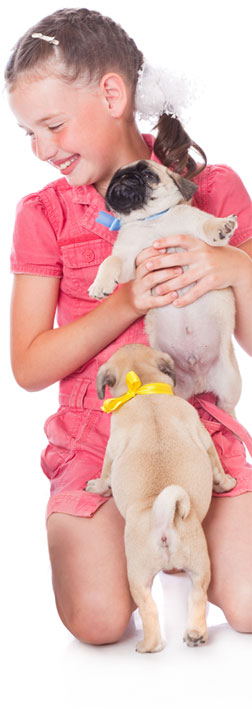If you see this icon in a fact sheet summary you may be dealing with a life threatening issue. Consult a veterinarian immediately.
Use our webform to ask a question or book an appointment

LUXATING PATELLA
The patella is the bone commonly called the knee cap. In the dog, normal movement is for the patella to slide up and down within a groove on the femur — the thigh bone, the bone above the knee joint — as the knee is bent and straightened. Sometimes a patella will luxate (dislocate), meaning it slips out of this groove and to the side.
A luxating patella will always cause discomfort for the dog and in chronic cases the pain will be severe. Left untreated arthritis will develop, leading to further chronic pain.
SEVERITY: Initially mild developing to severe. Treatable by surgical correction.
A luxating patella may be caused in one of two ways. It may be an inherited (genetic) problem. Depending on the breed and size of the dog in most small dogs the patella usually luxates medially (towards the mid line of the patient, i.e., to between the legs rather than towards the outside of a leg). In large dogs the patella generally luxates laterally.
The degree of patella luxation caused by poor conformation of the leg varies from a looser than usual patella that generally stays in place but luxates when being examined, to a patella that is permanently luxated and cannot be manually replaced.
The signs of patella luxation therefore also vary — from occasional ‘skipping,’ where the leg is carried with the knee bent for one or more steps, to significant lameness. These signs are usually evident from a young age, although mild cases may not be noticed by owners until arthritis develops. This occurs at a younger than usual age causing more obvious significant lameness.
Conformation problems cause luxating patellae most commonly in toy and miniature dog breeds, for example chihuahuas, toy and miniature poodles, maltese and shih tzus. As this is a genetic problem, breeding of dogs with this problem should be avoided. Around 50 per cent of patients will have the problem in both knees, and around 15-20 per cent of those patients with chronic patella luxations will also rupture their cranial cruciate ligament. Patella luxation of this type usually worsens over time.
A second cause is trauma, such as a hard knock to the knee. In these cases the patella will luxate to one or both sides and the patient will show signs of sudden onset lameness, pain and swelling.
A luxating patella is usually obvious after a simple physical examination and a visual observation of the dog’s gait. We will however take radiographs prior to surgical correction to establish the extent of surgical repair required.
Apart from the mildest cases, all patella luxations require surgical correction. More severe cases suffer constant pain and lameness. All cases, even the mild cases that don’t appear as much of a problem for the young pet, will lead to early arthritis from the constant abnormal rubbing of bone, gradually wearing away the cartilage lining the bone. Arthritis can be very painful and early prevention by surgical correction of the problem is the best way to protect your pet from future pain and discomfort.
The degree of patella luxation determines the degree of repair performed. For a simple lateral ligation your dog will be home the same day. Severe cases requiring groove deepening and lateral ligation involves an overnight stay in the hospital for monitoring.
Procedures performed include:
- Surgically deepening the patella groove
- Tibial crest transposition
- Medial desmotomy, which involves releasing tissues on the medial side of the joint.
- Lateral imbrication, or the tightening of tissues on the lateral side of the joint.
Pain relief is given to minimise pain and encourage movement.
Home care after surgery is an important part of recovery. If your pet is not using the leg, physiotherapy by gently bending and straightening the leg is recommended. Short, gentle, slow leash walks on even ground surfaces should also begin a few days after surgery. These should initially be only for a few minutes, gradually increasing in length over the following 6 to 8 weeks.
The aim is to encourage early but controlled use of the leg. Exercise must be carefully restricted to prevent injury. After the first two weeks, swimming is excellent exercise for the leg, as it is non-weight bearing and reduces the chance of slipping and injuring the leg as well as forcing those reluctant patients to start using the leg again.
Healing time ranges from around 4 to 10 weeks depending on the surgical techniques needed for repair. Overweight pets put extra stress on all joints and should be brought back to normal weight. Please discuss your pet’s weight with our staff to ensure a desired weight loss is achieved.
We will begin a course of pentosan (anti-arthritis) injections one week after surgery. This involves a course of 4 weekly injections followed by monthly or 3 monthly boosters depending on whether arthritis is already present.
MORE DISEASES OF DOGS
DOGS: ADVICE FOR EMERGENCIES




